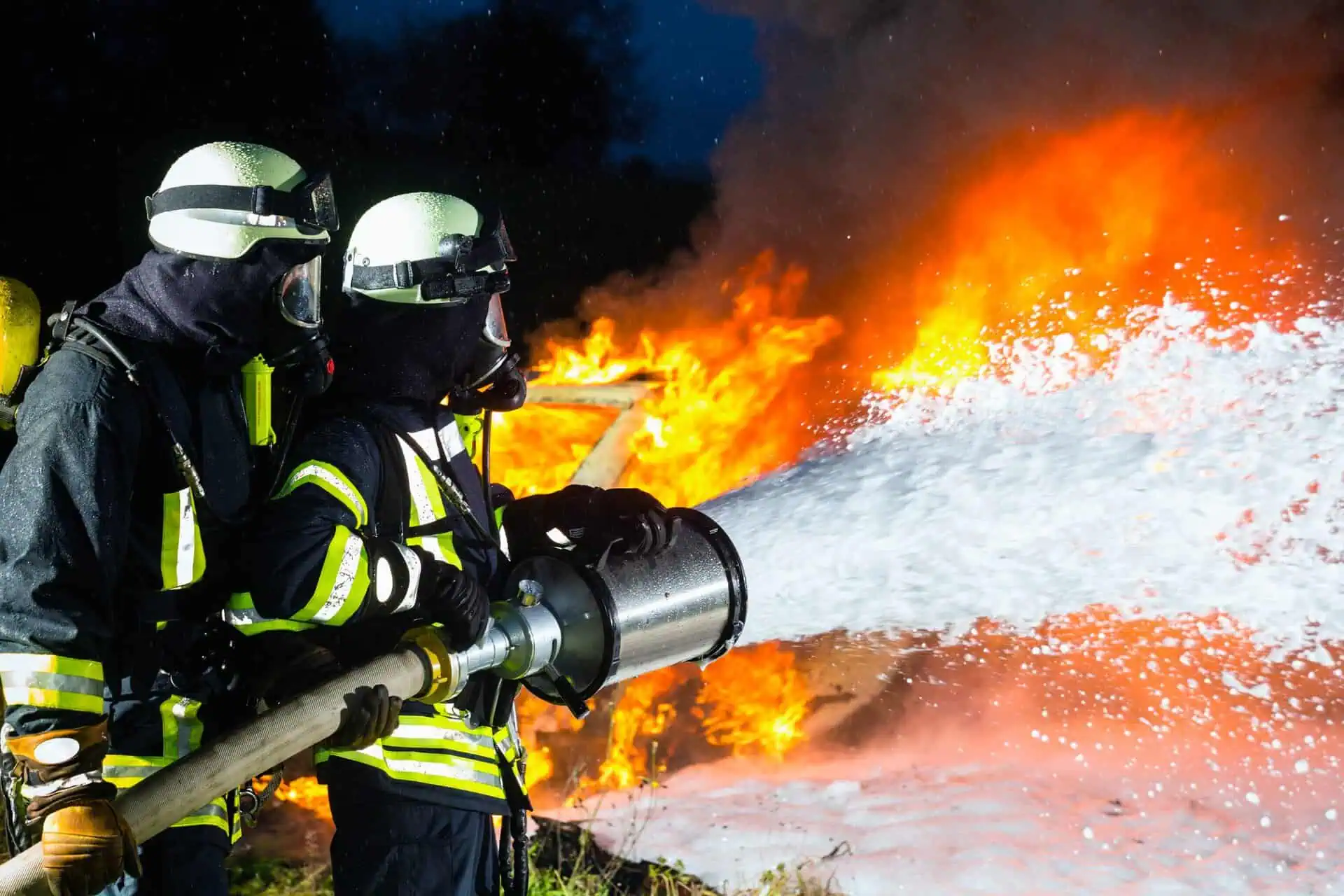AFFF Firefighting Foam Lawsuit: Health Conditions & Risks
- Last Updated: June 12th, 2025

Attorney Jessica Paluch-Hoerman, founder of TruLaw, has over 28 years of experience as a personal injury and mass tort attorney, and previously worked as an international tax attorney at Deloitte. Jessie collaborates with attorneys nationwide — enabling her to share reliable, up-to-date legal information with our readers.
Legally Reviewed
This article has been written and reviewed for legal accuracy and clarity by the team of writers and legal experts at TruLaw and is as accurate as possible. This content should not be taken as legal advice from an attorney. If you would like to learn more about our owner and experienced injury lawyer, Jessie Paluch, you can do so here.
Fact-Checked
TruLaw does everything possible to make sure the information in this article is up to date and accurate. If you need specific legal advice about your case, contact us by using the chat on the bottom of this page. This article should not be taken as advice from an attorney.
Key takeaways:
- AFFF firefighting foams contain toxic substances known as PFAS, which are linked to several types of cancer and other health issues such as liver damage and thyroid disease.
- Plaintiffs allege that manufacturers of AFFF knew about the health risks but failed to warn the public, leading to numerous lawsuits filed by individuals, state governments, and organizations like the International Association of Fire Fighters (IAFF).
- Settlements in 2023 for municipal water contamination lawsuits against AFFF manufacturers reached over $10 billion.
Overview of AFFF Firefighting Foam Lawsuit: Health Conditions & Risks
On this page, we’ll provide an overview of the AFFF Firefighting Foam Lawsuit, investigate the impact of AFFF Firefighting Foam on human health conditions, legal grounds to file an AFFF Firefighting Foam Lawsuit, and much more.
Intro to the AFFF Firefighting Foam Lawsuit
The number of cancer cases related to AFFF exposure is increasing as studies point toward a connection between AFFF firefighting foam and the risk of experiencing severe health conditions.
These cases are most frequently found among firefighters, military personnel, and residents affected by contaminated municipal water.
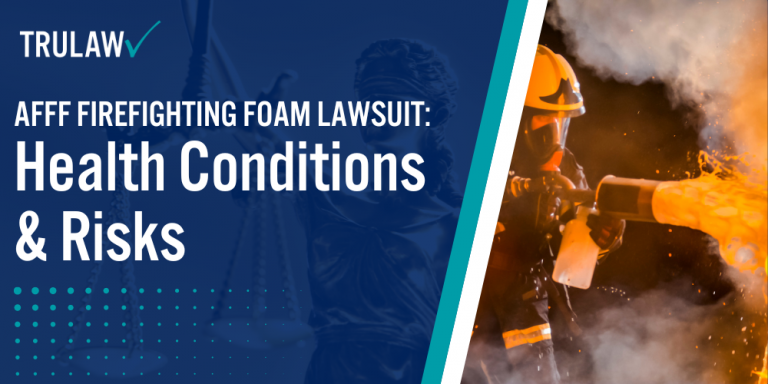
Forms of cancer most commonly found in the AFFF firefighting foam lawsuit include, but are not limited to:
- Kidney
- Liver
- Prostate
- Testicular
- Various other forms of cancer
If you or a loved one has suffered from health complications linked to AFFF foam chemicals, contact TruLaw using the chat on this page to receive an instant case evaluation.
Table of Contents
Legal Grounds to File an AFFF Firefighting Foam Lawsuit
Victims exposed to toxic AFFF firefighting foams often face serious health risks, including various types of cancer.
The mounting evidence and scientific studies that link AFFF exposure to illnesses such as kidney cancer, testicular cancer, and thyroid disease provide a strong basis for personal injury claims.
These lawsuits allege that manufacturers knew about the dangers of PFAS chemicals in their products but failed to warn the public or those most at risk like firefighters and military personnel.
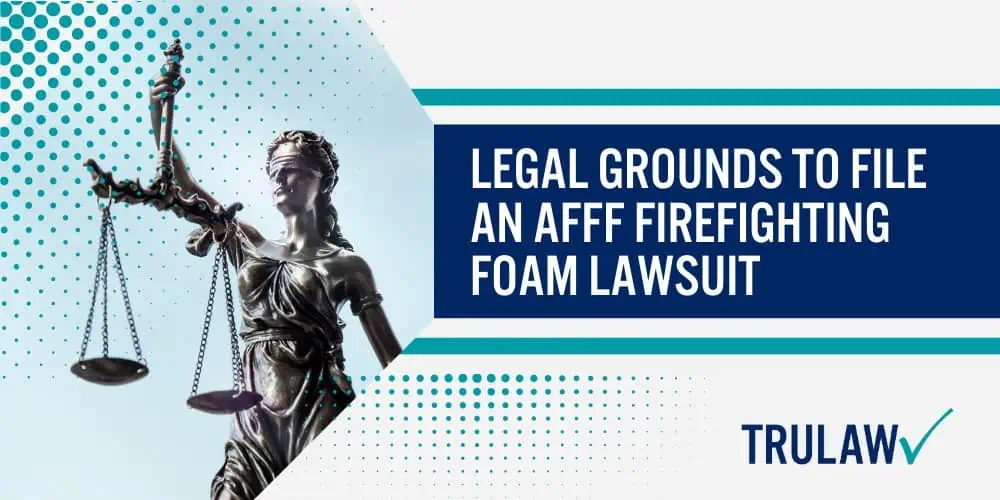
State governments have also taken manufacturers to court over the contamination of municipal water supplies with these harmful substances.
Additionally, organizations like the International Association of Fire Fighters (IAFF) are fighting back through litigation by claiming that certain entities bear responsibility for exposing fire professionals to dangerous chemicals without adequate protection or warnings.
Rise of Cancer Cases Reported: AFFF Exposure
The number of cancer diagnoses linked to AFFF exposure is climbing, raising alarm and prompting legal action. Research points to AFFF, a toxic firefighting foam, as a potential cause of life-threatening conditions like prostate, kidney, and testicular cancer.
Victims have reported that after years of handling or being near AFFF during their duties extinguishing jet fuel fires or in other high-risk environments, they developed cancers they believe are directly related to this hazardous substance.
Manufacturers now face numerous lawsuits from individuals who claim these companies knew about the dangers for decades yet failed to inform the public or take steps to mitigate those risks.
With each lawsuit filed by firefighters, military personnel, and residents exposed to contaminated municipal water supplies, awareness grows about the devastating health impacts of AFFF exposure.
These cases form part of an MDL (multidistrict litigation) aimed at achieving justice for affected populations across the United States. Moving forward from this point brings us closer to understanding Non-Cancer Health Risks associated with AFFF Exposure.
Non-Cancer Health Risks: AFFF Exposure
While cancer risks have garnered significant attention, it’s essential to recognize that exposure to AFFF firefighting foam is linked to various non-cancer health issues as well. Discoveries in environmental and medical research indicate that the toxic chemicals known as PFAS found in AFFF are a cause for concern beyond their carcinogenic properties.
Individuals who come into contact with these substances may suffer from conditions such as liver damage, high cholesterol levels, thyroid disease, ulcerative colitis, and pregnancy-induced hypertension or preeclampsia.
Moreover, PFAS compounds have been associated with immune system impairments. Research suggests that such exposure can lead to reduced antibody responses to vaccines and increased rates of asthma and other respiratory issues.
Investigating the Impacts on Human Health: AFFF Exposure
Scientists and health experts are delving into how AFFF, with its toxic PFAS chemicals, affects our bodies. They have discovered that these substances can accumulate over time, potentially leading to a host of medical concerns.
With AFFF’s long-lasting presence in the environment, figuring out the full extent of its impact is a top priority. Experts are especially focused on understanding how exposure leads to various types of cancer and other serious illnesses.
Researchers continue to study the link between firefighting foam containing AFFF and harmful health outcomes. Their work helps shed light on why certain cancers may be more prevalent among individuals who’ve had contact with this foam.
These studies play a crucial role in supporting legal claims by providing concrete evidence of the dangers associated with AFFF use in firefighting activities.
AFFF Firefighting Foam Lawsuits: Potential Compensation
In the wake of health concerns, those affected by AFFF firefighting foam are seeking justice and compensation for their suffering through litigation, with the potential for recovering substantial damages that reflect the severity of their exposure and subsequent health issues.
AFFF Firefighting Foam Lawsuits: Recoverable Damages
Victims of AFFF exposure are taking legal action and fighting for compensation.
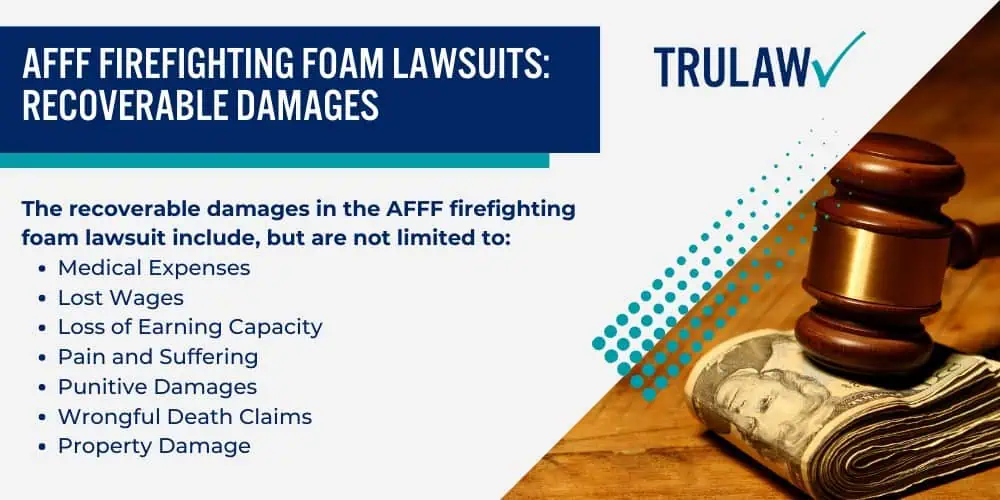
The recoverable damages in the AFFF firefighting foam lawsuit include, but are not limited to:
- Medical Expenses: Cover the costs of current and future medical treatments, including doctor visits, hospital stays, chemotherapy, radiation, surgery, and any other ongoing healthcare needs.
- Lost Wages: Compensate for income lost due to being unable to work while undergoing treatment or recovering from illness related to AFFF exposure.
- Loss of Earning Capacity: If the exposure causes long-term health effects that prevent a person from maintaining their previous level of employment, this aims to compensate for that loss.
- Pain and Suffering: Acknowledge and provide relief for the physical pain and emotional distress endured as a result of illnesses caused by AFFF chemicals.
- Punitive Damages: In cases where negligence is proven, punitive damages serve as a punishment to deter the manufacturers from future misconduct.
- Wrongful Death Claims: Families who have lost loved ones due to diseases linked with AFFF can pursue claims to cover funeral expenses and loss of companionship.
- Property Damage: Some lawsuits seek compensation for property damage due to contamination of water supplies caused by AFFF products.
Determining Compensation: Key Factors in AFFF Foam Lawsuits
Determining the proper compensation in AFFF firefighting foam lawsuits requires careful consideration of several factors.
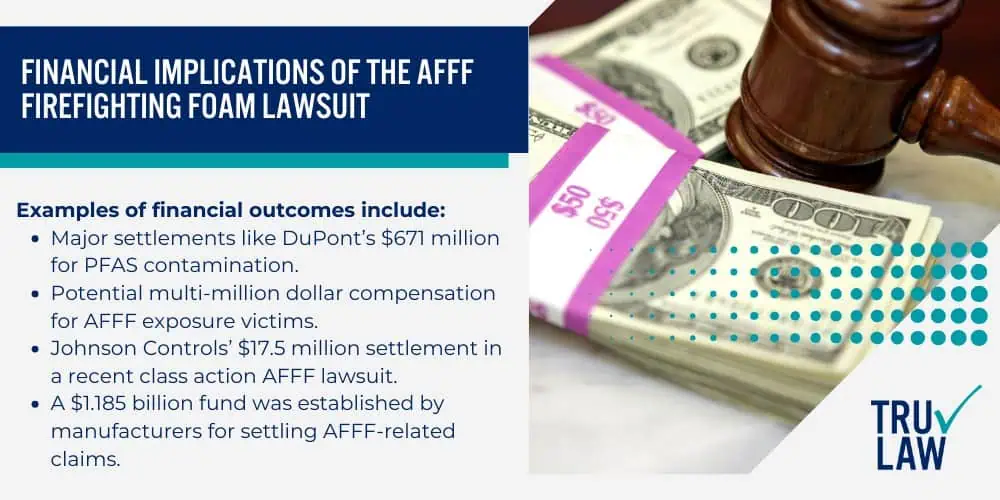
Plaintiffs should assess the following details to establish a fair claim:
- The Extent of Exposure: Claimants must demonstrate how long and intensely they were exposed to AFFF-contaminated products. Prolonged exposure can lead to higher compensation due to increased health risks.
- Medical Expenses Incurred: Bills and records from hospitals and clinics play a crucial role. They outline the financial impact of the illness linked to AFFF, guiding the reimbursement calculation.
- Proof of Diagnosis: Solid evidence such as medical reports confirming cancer or other illnesses caused by AFFF is crucial. A precise diagnosis strengthens the case for substantial compensation.
- Impact on Quality of Life: Compensation often reflects how exposure has affected a person’s daily activities and overall well-being. Chronic pain, inability to work, or lifestyle changes add weight to the compensation claims.
- Loss of Earnings: Documented proof showing lost wages or reduced earning capacity due to illness is essential. Courts consider this when awarding damages for financial instability caused by AFFF-related health issues.
- Future Medical Treatment Costs: If ongoing care is needed, projected future medical expenses are included in settlements. Accurate estimations ensure that plaintiffs are covered for long-term treatment.
AFFF Firefighting Foam Lawsuits: Current Litigation
Courtrooms across the nation are currently bustling with AFFF firefighting foam cases. Victims and their families are taking a stand, seeking justice for illnesses they claim were caused by exposure to toxic substances in AFFF foams.
Many of these lawsuits have been consolidated into multidistrict litigation (MDL) to streamline the process due to the similarity of claims around health risks such as cancer linked to PFAS exposure.
Law firms like TruLaw represent individuals fighting for compensation against big manufacturers who allegedly knew about but neglected the dangers associated with AFFF products.
With each case brought forward, more light is shed on occupational exposure risks and environmental impacts from this potentially hazardous foam, reinforcing how crucial it is for those affected to come forward and seek legal counsel.
Filing an AFFF Firefighting Foam Lawsuit
If you or a loved one has been exposed to AFFF firefighting foam and are experiencing health issues, taking legal action could be a crucial step towards compensation.
Our skilled team at TruLaw is ready to navigate the intricacies of these highly specialized lawsuits on your behalf.
Gathering Evidence: Aqueous Film Forming Foam Exposure
Building a solid case in AFFF litigation requires detailed evidence of exposure to Aqueous Film Forming Foam.
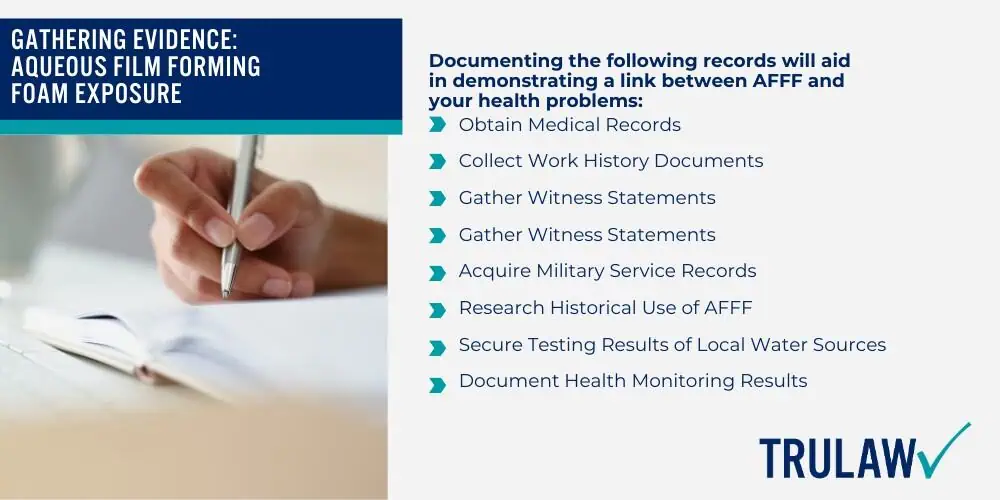
Documenting the following records will aid in demonstrating a link between AFFF and your health problems:
- Obtain Medical Records: Your complete medical history can provide a timeline for diagnosing conditions potentially linked to AFFF.
- Collect Work History Documents: Prove your presence at sites where AFFF was regularly used, showing direct potential contact with the foam.
- Gather Witness Statements: Colleagues or other witnesses can corroborate your exposure to AFFF in various settings.
- Acquire Military Service Records: Veterans should secure records that detail their duty stations and roles, indicating possible AFFF contact.
- Research Historical Use of AFFF: Confirm that firefighting foam was used at your location through reports or inventories.
- Secure Testing Results of Local Water Sources: Water contamination from PFAS in areas where you lived or worked supports exposure claims.
- Document Health Monitoring Results: Ongoing health evaluations may reflect changes attributed to long-term exposure to PFAS chemicals found in AFFF.
Choosing an AFFF Firefighting Foam Lawsuit Attorney: TruLaw
Selecting the right attorney for your AFFF firefighting foam lawsuit can greatly influence the outcome.
TruLaw’s team excels in managing these complex cases, having a keen focus on environmental and product liability law.
Their experience with cancer-related lawsuits stemming from AFFF exposure positions them as a prime choice to handle such sensitive matters.
Committing to clients impacted by film forming foam AFFF, they aim to achieve justice and fair compensation.
TruLaw approaches each case with a tailored strategy, considering individual circumstances around afff firefighting foam mdl and potential health risks.
They understand the gravity of facing conditions like prostate cancer due to chemical exposures at work or home.
Litigation Process: AFFF Firefighting Foam Lawsuit
Navigating the legal system can be complex, especially in a AFFF firefighting foam lawsuit.
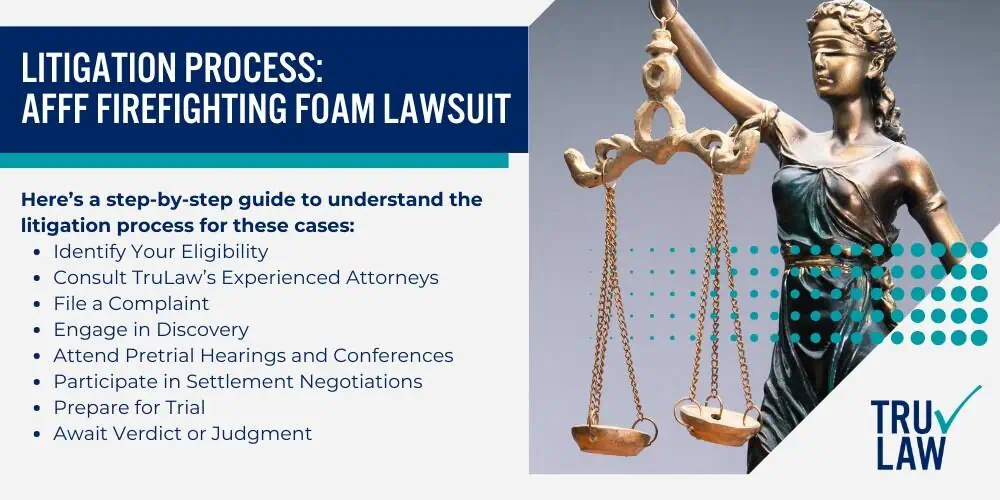
Here’s a step-by-step guide to understand the litigation process for these cases:
- Identify Your Eligibility: Before proceeding, you must determine whether your exposure to AFFF firefighting foam qualifies you to file a lawsuit. This step confirms that your health condition is linked to AFFF exposure.
- Consult TruLaw’s Experienced Attorneys: Reach out to our dedicated team with proficiency in environmental and product liability lawsuits. They will provide expert guidance on the merits of your case.
- File a Complaint: The initial document filed in court, usually by AFFF lawyers, details your allegations against the manufacturers and how their products have harmed you.
- Engage in Discovery: During this phase, both sides exchange information through depositions, document requests, and interrogatories. Discovery aims to gather evidence supporting your claim.
- Attend Pretrial Hearings and Conferences: These court proceedings ensure that the case progresses efficiently and all parties comply with procedural rules.
- Participate in Settlement Negotiations: Many cases are resolved without going to trial through negotiations between your attorney and the defendant’s representatives. If an agreement is reached, it may result in an AFFF lawsuit settlement.
- Prepare for Trial: If no settlement occurs, your case will head to trial, where both sides present evidence before a judge or jury. Your lawyers will argue why compensation should be awarded based on harm caused by AFFF firefighting foam exposure.
- Await Verdict or Judgment: After hearing all evidence and arguments, the judge or jury will decide, which could include financial damages for your suffering and losses.
If you or a loved one has suffered from health complications linked to AFFF foam chemicals, contact TruLaw using the chat on this page to receive an instant case evaluation.
AFFF Litigation: Possible Settlements in 2023
Discover the latest developments in AFFF litigation and explore possible settlements in 2023, paving the way for affected individuals to secure justice and compensation – stay informed about your rights with TruLaw.
Municipal Water Contamination
Municipal water systems have faced a crisis with AFFF firefighting foams seeping into the supply, leading to widespread contamination concerns.
The persistent presence of PFAS chemicals in our water poses a severe risk to public health and safety.
Towns and cities across the country are now taking action, spurred by evidence linking these substances to harmful conditions including cancer.
Victims of this contamination have sought justice through municipal water contamination lawsuits, aiming for accountability from foam manufacturers.
In an unprecedented move, municipalities approached a historic global settlement in 2023 valued at over $10 billion.
This legal milestone allows communities affected by toxic exposure to pursue fair compensation and prompts stricter scrutiny on how AFFF products are managed.
Individual Claims: A New Focus in AFFF Litigation
In recent developments, personal stories are taking center stage in the fight against AFFF manufacturers.
Individuals stepping forward with claims of serious health conditions linked to firefighting foam exposure mark a significant shift in legal strategies.
With each unique case, lawyers are piecing together evidence that shows widespread harm and deeply personal impacts.
Courageous firefighters and community members affected by AFFF join these battles for accountability.
Their claims aren’t just numbers; they’re snapshots of lives altered by illness.
Firefighting foam cancer lawyers work tirelessly to secure justice for those who have suffered from kidney and testicular cancer, among other health issues, believing that the path to change is through highlighting individual voices in this complex litigation maze.
If you or a loved one has suffered from health complications linked to AFFF foam chemicals, contact TruLaw using the chat on this page to receive an instant case evaluation.
Pursuing Justice In The AFFF Foam Lawsuit
Navigating the landscape of AFFF litigation can be complex, but for those affected by firefighting foam exposure, pursuing justice is a critical step toward compensation – continue reading to understand how you can initiate your claim and potentially join the nationwide AFFF lawsuit.
Eligibility requirements: AFFF Firefighting Foam Lawsuits
Determining eligibility for an AFFF firefighting foam lawsuit is crucial if you’ve been exposed to harmful chemicals.
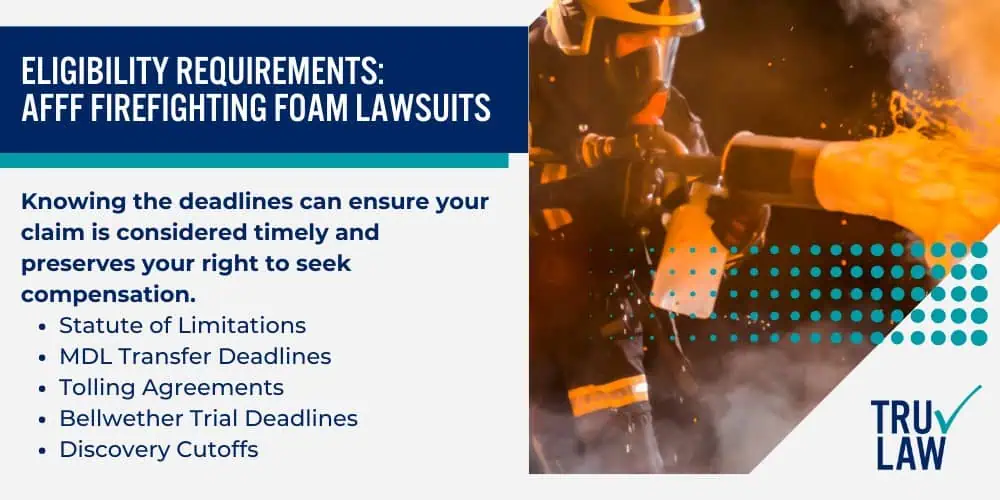
Here’s what you need to know to see if you can file an AFFF firefighting foam lawsuit:
- Proof of exposure to AFFF: You must have evidence that shows you were in contact with AFFF.
- Connection to cancer or other health issues: Medical records should link your health condition directly to the exposure.
- Timely filing within legal deadlines: Your claim must be submitted before the statute of limitations expires.
- Affected by PFAS chemicals: You must illustrate that your illness resulted from per- and poly-fluoroalkyl substances found in AFFF.
- Use of contaminated water sources: Show that your drinking water was tainted due to AFFF usage, leading to municipal water contamination cases.
- Service in relevant industries or locations: Military personnel, airport workers, and firefighters are commonly affected by such exposures.
AFFF Firefighting Foam Lawsuit Deadlines
Time is crucial in legal matters, especially when filing an AFFF firefighting foam lawsuit.
Knowing the deadlines can ensure your claim is considered timely and preserves your right to seek compensation.
- Statute of Limitations: Each state sets its own timeframe for when you must file a lawsuit. This period may vary, but typically ranges from one to six years from the date you discover or should have discovered the harm from AFFF exposure.
- MDL Transfer Deadlines: If your case becomes part of the multidistrict litigation (afff mdl), you may need to adhere to specific cutoff dates set by the court for joining the centralized proceedings.
- Tolling Agreements: In some instances, parties might agree to toll, or pause, the statute of limitations while they negotiate potential settlements. Keep informed about any such agreements that could affect your claim.
- Bellwether Trial Deadlines: Leading up to bellwether trials in an MDL (bellwether afff trial), strict deadlines usually apply for case selection, discovery, and pretrial motions—missing these can jeopardize your involvement in these critical test cases.
- Discovery Cutoffs: Legal discovery involves gathering evidence for your firefighting foam afff lawsuits; courts often impose cutoff dates by which discovery must be completed.
Initiating Your AFFF Foam Lawsuit
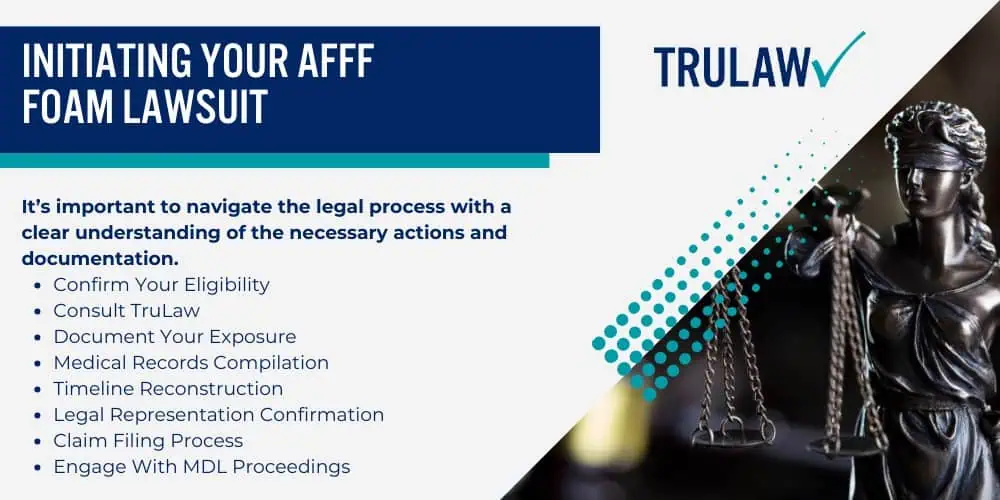
Starting your AFFF foam lawsuit requires precise steps to ensure your case is handled effectively. It’s important to navigate the legal process with a clear understanding of the necessary actions and documentation.
- Confirm Your Eligibility: Verify that you meet the criteria for filing a claim, which includes having been exposed to AFFF firefighting foam and receiving a cancer diagnosis potentially linked to that exposure.
- Consult TruLaw: Reach out to our team of knowledgeable AFFF lawyers through the chat on this page. We’ll review your situation in detail and advise you on the viability of your claim.
- Document Your Exposure: Collect any evidence of your exposure to AFFF firefighting foams, including employment records if you were in occupational contact with these substances.
- Medical Records Compilation: Gather all relevant medical documents that support your cancer diagnosis and assert its connection to AFFF exposure.
- Timeline Reconstruction: Work with TruLaw attorneys to reconstruct a timeline of exposure, noting crucial instances where contact with AFFF occurred.
- Legal Representation Confirmation: Officially appoint TruLaw as your representative in court, as we are committed to advocating for justice in your case without reference to competitors.
- Claim Filing Process: Together with TruLaw, file an official complaint within the appropriate jurisdiction. Our experienced team will handle the necessary paperwork and submissions according to United States District Court protocols.
- Engage With MDL Proceedings: If applicable, involve yourself in multidistrict litigation (MDL) procedures; TruLaw will guide you through any collective actions such as the federal AFFF lawsuits.
If you or a loved one has suffered from health complications linked to AFFF foam chemicals, contact TruLaw using the chat on this page to receive an instant case evaluation.
AFFF Firefighting Foam Lawsuit: Holding Manufacturers Accountable
The AFFF firefighting foam lawsuit landscape is complex, with a growing number of plaintiffs, predominantly firefighters and affected community members, challenging AFFF manufacturers.
In these lawsuits, individuals who developed cancer after exposure to Aqueous Film-Forming Foam (AFFF) contend that manufacturers knowingly sold toxic products without proper health risk disclosures.
This legal struggle is pivotal, representing a significant movement for truth and justice against entities that may have favored profit over safety, consequently endangering public health.
Plaintiffs’ Allegations and Defendants’ Response in the AFFF Firefighting Foam Lawsuit
Plaintiffs in the AFFF firefighting foam lawsuits form a coalition seeking justice for their health issues.
They accuse manufacturers of being aware of the carcinogenic risks of AFFF but choose silence over safety.
The impact of this alleged negligence is widespread, affecting numerous individuals who unknowingly came into contact with these harmful chemicals.
Key points from plaintiffs’ allegations:
- Alleging that AFFF manufacturers ignored evidence of AFFF’s link to cancer.
- Demanding accountability for health issues resulting from AFFF exposure.
- Highlighting the role of AFFF in contaminating public water and endangering firefighters and communities.
Defendants’ strategies in response:
- Refuting the health hazard claims associated with AFFF.
- Contesting the causation between AFFF exposure and plaintiffs’ health conditions.
- Focusing on the uncertainties of linking AFFF to specific medical conditions.
In responding, defendants face not only the AFFF firefighting foam lawsuit challenges but also public scrutiny over their ethical practices and product safety, impacting their industry reputation and future.
Attorney General Josh Stein of North Carolina filed lawsuits against several AFFF manufacturers, including DuPont, Chemours, and 3M, over the contamination caused by these products (NCDOJ).
Financial Implications of the AFFF Firefighting Foam Lawsuit
The AFFF firefighting foam lawsuit is marked by significant financial outcomes, highlighting the gravity of the health risks involved.
These settlements reflect the personal suffering of those affected and underscore the responsibility of manufacturers towards consumer safety.
The lawsuit outcomes have also sparked a call for stricter regulations in the chemical industry, particularly for products like AFFF.
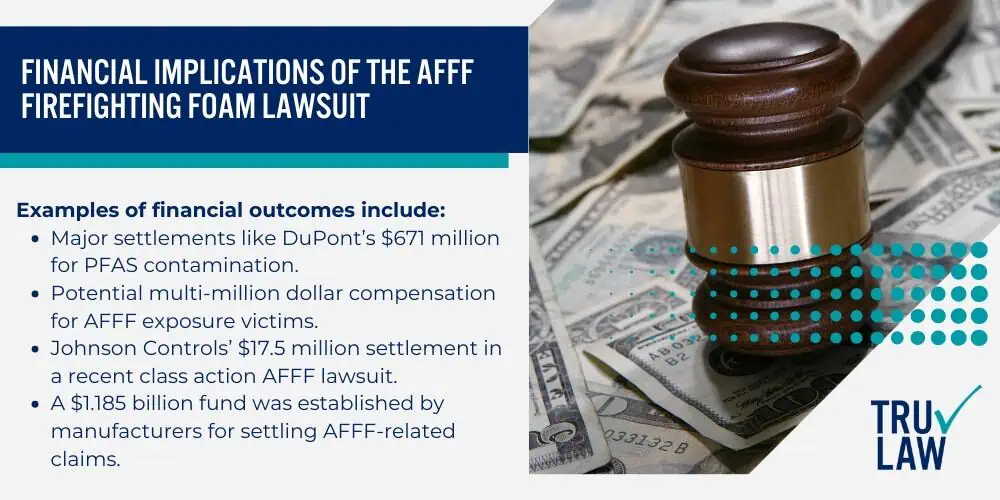
Examples of financial outcomes include:
- Major settlements like DuPont’s $671 million for PFAS contamination.
- Potential multi-million dollar compensation for AFFF exposure victims.
- Johnson Controls’ $17.5 million settlement in a recent class action AFFF lawsuit.
- A $1.185 billion fund was established by manufacturers for settling AFFF-related claims.
These financial ramifications of the AFFF firefighting foam lawsuit are expected to continue shaping manufacturer policies, leading to safer industry practices and more transparent operations in the long run.
The U.S. Department of Defense has also been involved in addressing the challenges posed by AFFF, particularly in terms of researching methods to detect PFAS in firefighting foam.
Additionally, lawsuits like those filed by Attorney General Phil Weiser in Colorado and Michigan further underscore the national scope of this issue, highlighting the broad concerns regarding the toxic chemicals in AFFF and their impact on public health and the environment.
If you or a loved one has suffered from health complications linked to AFFF foam chemicals, contact TruLaw using the chat on this page to receive an instant case evaluation.
Concluding Thoughts of the AFFF Firefighting Foam Lawsuit
The legal actions in the AFFF firefighting foam lawsuit stem from allegations that the chemicals in AFFF foam are linked to serious health issues, including cancer, high blood pressure, birth complications, and more.
A significant aspect of these lawsuits is the claim that these chemicals have contaminated drinking water sources.
If you or a loved one has suffered from health complications linked to AFFF foam chemicals, contact TruLaw using the chat on this page to receive an instant case evaluation.
AFFF Lawsuit Frequently Asked Questions
-
What is the AFFF firefighting foam lawsuit?
The AFFF firefighting foam lawsuit is a class action case involving claims of water contamination and personal injury due to exposure to Aqueous Film Forming Foam (AFFF).
The lawsuit targets companies that manufactured and sold AFFF products, alleging that exposure to chemicals in these products led to the development of certain types of cancer.
Many cases are pending, with over 6,000 reported in the Multi-District Litigation (MDL). It is believed that most of these cases will be resolved in 2024 through a global settlement.
If you or a loved one has suffered from health complications linked to AFFF foam chemicals, contact TruLaw using the chat on this page to receive an instant case evaluation.
-
Who can join the class action MDL for AFFF?
Individuals who regularly use AFFF as part of their job and have been diagnosed with conditions such as testicular cancer and kidney cancer qualify to file a firefighting foam cancer lawsuit without any issues.
Firefighters, military personnel, and individuals living near contaminated areas are also eligible.
If you or a loved one has suffered from health complications linked to AFFF foam chemicals, contact TruLaw using the chat on this page to receive an instant case evaluation.
-
What are the common health risks associated with AFFF exposure?
Exposure to AFFF can lead to several health problems, including asthma, developmental changes in children, immune system changes, cholesterol problems, fertility issues, increased risk of cancers, liver damage, pregnancy-induced hypertension/preeclampsia, thyroid disease, and ulcerative colitis.
If you or a loved one has suffered from health complications linked to AFFF foam chemicals, contact TruLaw using the chat on this page to receive an instant case evaluation.
-
Have there been any significant settlements in the AFFF lawsuits?
Yes, there have been significant settlements in the AFFF lawsuits.
All municipal and local water authority AFFF cases have been resolved with the named defendants, including Dupont and 3M, agreeing to pay a substantial amount of $10.3 billion to settle all these cases.
If you or a loved one has suffered from health complications linked to AFFF foam chemicals, contact TruLaw using the chat on this page to receive an instant case evaluation.

Managing Attorney & Owner
With over 25 years of legal experience, Jessica Paluch-Hoerman is an Illinois lawyer, a CPA, and a mother of three. She spent the first decade of her career working as an international tax attorney at Deloitte.
In 2009, Jessie co-founded her own law firm with her husband – which has scaled to over 30 employees since its conception.
In 2016, Jessie founded TruLaw, which allows her to collaborate with attorneys and legal experts across the United States on a daily basis. This hypervaluable network of experts is what enables her to share the most reliable, accurate, and up-to-date legal information with our readers!
Additional AFFF Lawsuit resources on our website:
Here, at TruLaw, we’re committed to helping victims get the justice they deserve.
Alongside our partner law firms, we have successfully collected over $3 Billion in verdicts and settlements on behalf of injured individuals.
Would you like our help?
At TruLaw, we fiercely combat corporations that endanger individuals’ well-being. If you’ve suffered injuries and believe these well-funded entities should be held accountable, we’re here for you.
With TruLaw, you gain access to successful and seasoned lawyers who maximize your chances of success. Our lawyers invest in you—they do not receive a dime until your lawsuit reaches a successful resolution!
AFFF Lawsuit claims are being filed against manufacturers of aqueous film-forming foam (AFFF), commonly used in firefighting.
Claims allege that companies such as 3M, DuPont, and Tyco Fire Products failed to adequately warn users about the potential dangers of AFFF exposure — including increased risks of various cancers and diseases.
Depo Provera Lawsuit claims are being filed by individuals who allege they developed meningioma (a type of brain tumor) after receiving Depo-Provera birth control injections.
A 2024 study found that women using Depo-Provera for at least 1 year are five times more likely to develop meningioma brain tumors compared to those not using the drug.
Suboxone Tooth Decay Lawsuit claims are being filed against Indivior, the manufacturer of Suboxone, a medication used to treat opioid addiction.
Claims allege that Indivior failed to adequately warn users about the potential dangers of severe tooth decay and dental injuries associated with Suboxone’s sublingual film version.
Social Media Harm Lawsuits are being filed against social media companies for allegedly causing mental health issues in children and teens.
Claims allege that companies like Meta, Google, ByteDance, and Snap designed addictive platforms that led to anxiety, depression, and other mental health issues without adequately warning users or parents.
Transvaginal Mesh Lawsuits are being filed against manufacturers of transvaginal mesh products used to treat pelvic organ prolapse (POP) and stress urinary incontinence (SUI).
Claims allege that companies like Ethicon, C.R. Bard, and Boston Scientific failed to adequately warn about potential dangers — including erosion, pain, and infection.
Bair Hugger Warming Blanket Lawsuits involve claims against 3M — alleging their surgical warming blankets caused severe infections and complications (particularly in hip and knee replacement surgeries).
Plaintiffs claim 3M failed to warn about potential risks — despite knowing about increased risk of deep joint infections since 2011.
Baby Formula NEC Lawsuit claims are being filed against manufacturers of cow’s milk-based baby formula products.
Claims allege that companies like Abbott Laboratories (Similac) and Mead Johnson & Company (Enfamil) failed to warn about the increased risk of necrotizing enterocolitis (NEC) in premature infants.
Here, at TruLaw, we’re committed to helping victims get the justice they deserve.
Alongside our partner law firms, we have successfully collected over $3 Billion in verdicts and settlements on behalf of injured individuals.
Would you like our help?
